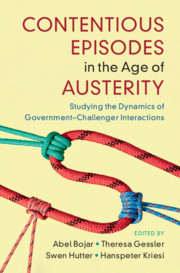 Contentious Episodes in the Age of Austerity
Contentious Episodes in the Age of Austerity Book contents
- Contentious Episodes in the Age of Austerity
- Cambridge Studies in Contentious Politics
- Contentious Episodes in the Age of Austerity
- Copyright page
- Contents
- Figures
- Tables
- Contributors
- Preface
- Part I A New Approach to the Analysis of Contentious Episodes
- Part II Varieties of Contention
- 4 Conceptualizing, Measuring, and Mapping Contentiousness
- 5 Actor Configurations and Coalitions in Contentious Episodes
- 6 Action Sequences and Dynamic Indicators of Contention
- 7 Outcomes: Government Responsiveness
- Part III Dynamics of Interaction
- Part IV Conclusion
- Appendices
- References
- Index
- Series page
5 - Actor Configurations and Coalitions in Contentious Episodes
from Part II - Varieties of Contention
Published online by Cambridge University Press: 05 November 2021
- Contentious Episodes in the Age of Austerity
- Cambridge Studies in Contentious Politics
- Contentious Episodes in the Age of Austerity
- Copyright page
- Contents
- Figures
- Tables
- Contributors
- Preface
- Part I A New Approach to the Analysis of Contentious Episodes
- Part II Varieties of Contention
- 4 Conceptualizing, Measuring, and Mapping Contentiousness
- 5 Actor Configurations and Coalitions in Contentious Episodes
- 6 Action Sequences and Dynamic Indicators of Contention
- 7 Outcomes: Government Responsiveness
- Part III Dynamics of Interaction
- Part IV Conclusion
- Appendices
- References
- Index
- Series page
Summary
So far, we have mapped what the three stylized actors did in the (more or less) contentious episodes, treating all three actors as unitary entities. This chapter takes the analysis a step further by describing features of the coalitions and actor configurations. In doing so, we answer who the actors involved in the conflicts over austerity and institutional reforms were and how they are typically related to each other. Available protest event studies on the Great Recession indicate at least three organizational features of the recent protest wave in Europe (e.g., Carvalho 2019; Diani and Kousis 2014; Hunger and Lorenzini 2019; Portos 2016, 2017; Portos and Carvalho 2019). First, they highlight the crucial role of institutionalized actors, particularly labor unions, in bringing the masses to the streets early on when the crisis hit the European continent in 2008 and 2009. Second, newly established and loose networks played an essential part in the southern European countries hit hardest by the crisis – the Portuguese Geração à Rasca, Democracia Real, and the Indignados in Spain as well as their Greek counterpart Aganaktismeni are illustrative of this dynamic. Third, the moment of such noninstitutionalized players who entered the protest scene tended to be relatively short lived, but, remarkably, even in Spain, there are indications of a process of institutionalization as formal organizations (trade unions and political parties) became more important in later phases of the protest wave.
- Type
- Chapter
- Information
- Contentious Episodes in the Age of AusterityStudying the Dynamics of Government–Challenger Interactions, pp. 91 - 109Publisher: Cambridge University PressPrint publication year: 2021
